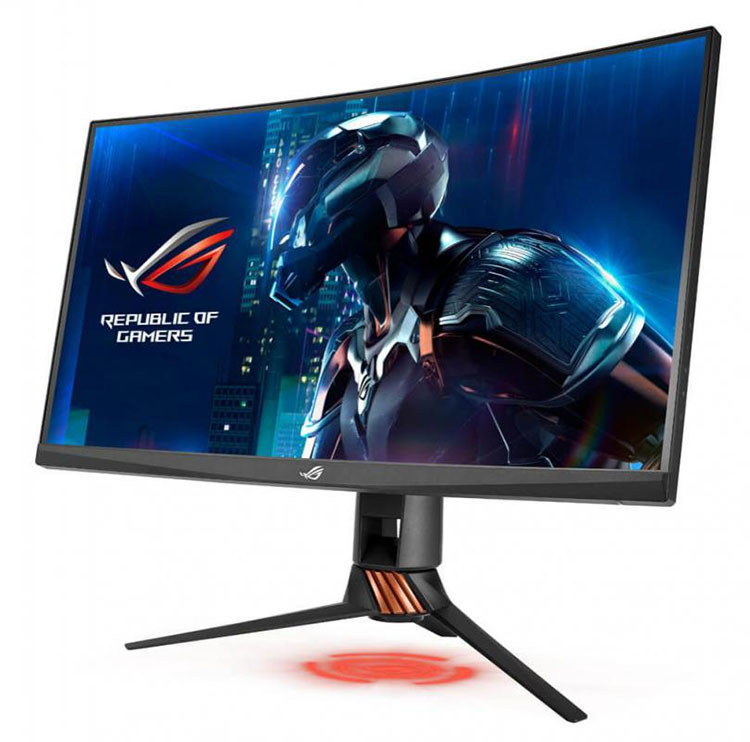Tom's Hardware Verdict
The Asus ROG Swift PG27V misses a few opportunities, but taken purely as a gaming display, it has few equals. Playing at high framerates in QHD resolution is easy with even a mid-priced video card. G-Sync ensures a smooth and tear-free experience, and lag is nearly non-existent. With a few tweaks, its weak out-of-box color accuracy can be corrected to provide excellent picture quality.
Pros
- +
165Hz refresh
- +
G-Sync
- +
Low lag & blur-free screen response
- +
High brightness
- +
Attractive, with good build quality
Cons
- -
Sub-par contrast & out-of-box accuracy
- -
Expensive
- -
No HDR or DCI color
Why you can trust Tom's Hardware
Features & Specifications
The ideal gaming monitor comes in multiple forms to fit the needs and desires of different users. But in our opinion, the size and resolution sweet spot is a 27” QHD/1440p panel. Ultra-wides are cool too but they often compromise performance for the sake of their extra pixels. The 109 pixels per inch (ppi) of a 1440p 27" screen offers a sharp and detailed image without appreciable artifacts like jaggies or line twitter around high-contrast objects. And 1440p is also an easy drive for mid-priced video cards at or around 60fps, while achieving 100fps doesn’t require a large investment PC graphics hardware.
Asus has embraced this formula with many past products and now brings an 1800R curvature to the party with the $799 screen we're investigating here. The PG27V sports QHD resolution through a 27”, 8-bit native panel that includes Nvidia's screen-smoothing G-Sync tech, ultra-low motion blur (ULMB), and a 165Hz refresh rate for those who crave ultimate refresh performance (and have the hardware to drive it). It also adds the Republic of Gamers line’s distinct styling and cool lighting features courtesy of Light In Motion and Aura Sync. Let’s take a look.
Yes, we were surprised to see a twisted nematic (TN) panel in a premium gaming monitor. Most would call this old-school technology, but new panels keep appearing from the major manufacturersa--and this one specifically comes from AU Optronics. Viewing angle issues are minimal thanks to the 1800mm curve radius, which provides a subtle wraparound effect with no hint of image distortion. In fact, given the screen’s 16:9 aspect ratio (unusual in a curved monitor), that curve almost completely eliminates light falloff or color shift for a centrally-seated user.
The panel otherwise has all the latest technology: 165Hz with overclock, G-Sync, and ULMB up to 120Hz. Light output is high at over 400 nits, which makes the blur reduction more usable since using it reduces brightness by around 50%. There is no HDR or extended color here. 2.2 power gamma and sRGB are the standard. But the high refresh rate, coupled with QHD resolution, means you won’t need a top-tier video card to edge above 100fps in your favorite games.
Packaging, Physical Layout & Accessories
The PG27V comes well-protected in a large and stout carton. Molded foam protects the curved panel, which already has its upright attached. The bar is permanent by the way, thanks to the lighting effects, so no third-party arms will work here. Assembly consists of attaching the base with a captive bolt and snapping the Light In Motion filter in place. You get three different lenses, that each project something different on the desktop. Bundled cables include HDMI, DisplayPort, and USB. The power supply is external and comes in Asus' now-famous Apple TV-shaped package. It’s much nicer-looking than the generic bricks we usually see. A CD provides the user manual and Aura Sync software.
Product 360

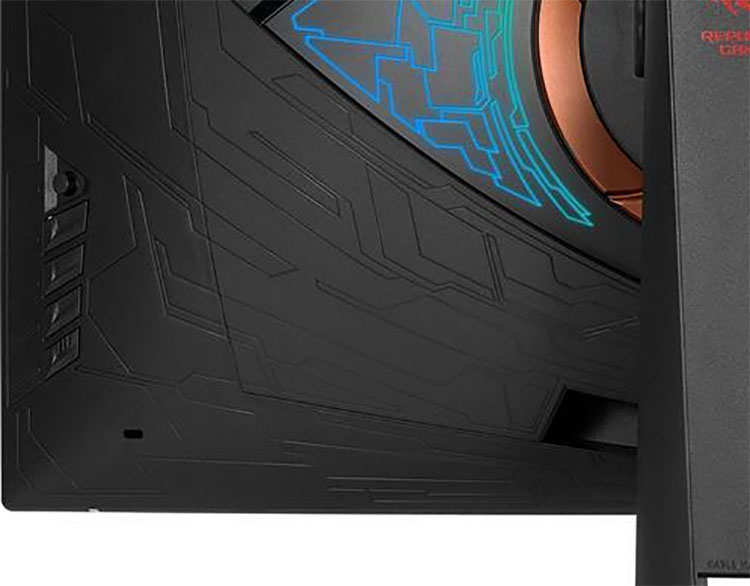
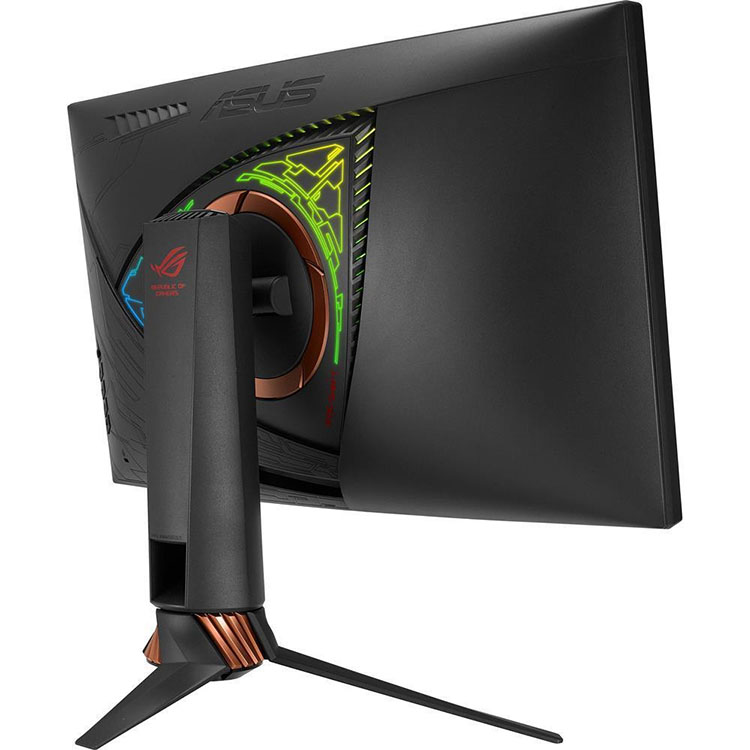
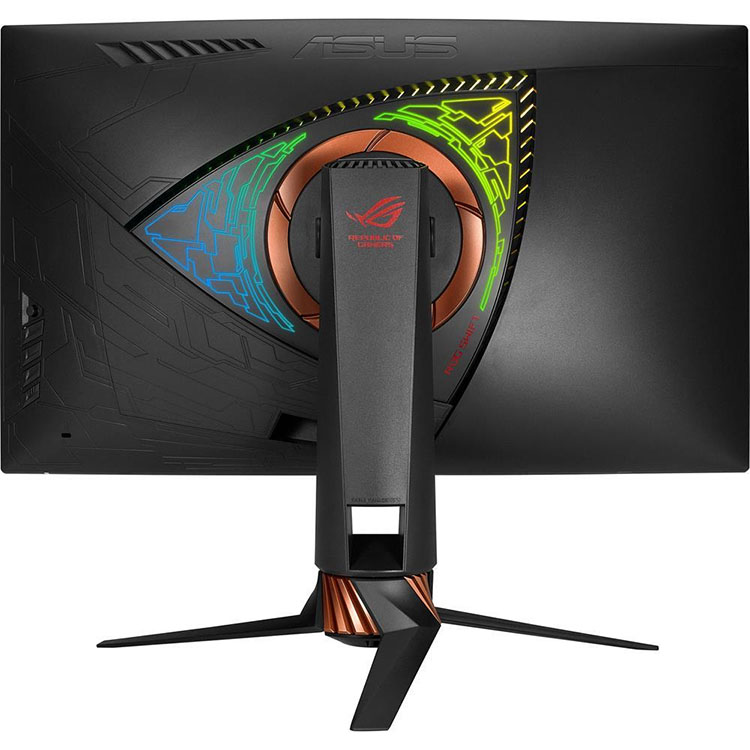
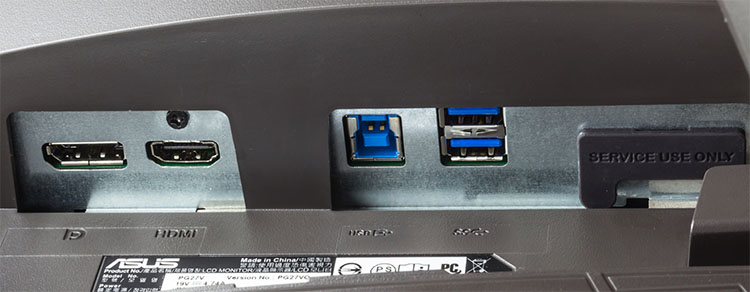
The PG27V goes for the minimal-bezel look, with a thin line around the top and sides and a larger bar across the bottom. The 1800R curve is subtle but effective. It pulls the screen’s sides in just enough to reduce any issues with the TN panel’s off-axis image quality. When sitting on-center at around 24” from the screen, the picture is uniform from edge to edge with no distortion. The anti-glare layer is very aggressive at blocking reflections but does not reduce clarity.
Asus’ spaceship-hull-like styling is present here with subtle moldings on the screen’s back cover. The lighting effects are top-shelf, with colored lines surrounding the upright’s attachment point. This can be controlled with Aura Sync, which varies the effect using software. You can also set different options in the OSD (more on that below). By default, the Light In Motion featue projects a ROG logo on your desktop beneath the monitor’s base at one of three different intensities.
Get Tom's Hardware's best news and in-depth reviews, straight to your inbox.
OSD control comes courtesy of Asus' perfectly-engineered joystick, which makes navigation a breeze. Four additional buttons provide direct access to picture modes and the Game Plus feature. The power button is now textured to help prevent accidental turn-offs, an issue we found in previous ROG monitors. The power LED is just visible below the right-bottom edge. It glows red for G-Sync, green for ULMB, and white in normal mode.
The stand offers firm and smooth adjustments that include 4” of height, 40° swivel in each direction, and 20° forward/5° backward tilt. Like most curved monitors, there is no portrait mode. Ventilation happens through a small grille in back, and we could feel some heat coming from the front of the screen, at the edges, though never became an issue though. There are no built-in speakers, only a headphone jack in the input panel.
Source connections cover the modern basics. You get one HDMI and one DisplayPort. USB 3.0 is supported through one upstream and two downstream ports. The panel is finished with the headphone output and a DC input for the power supply. At 200nits, we measured 32.5 watts of energy consumption with our Kill-A-Watt.
Specifications
| Panel Type & Backlight | TN / W-LED, edge array |
| Screen Size & Aspect Ratio | 27" / 16:9 |
| Curve Radius | 1800mm |
| Max Resolution & Refresh | 2560x1440 @ 144Hz / 165Hz w/overclock G-Sync & ULMB |
| Native Color Depth & Gamut | 8-bit / sRGB |
| Response Time (GTG) | 1ms |
| Brightness | 400cd/m2 |
| Contrast | 1000:01:00 |
| Speakers | ✗ |
| Video Inputs | (1) DisplayPort v1.2, (2) HDMI v1.4 |
| Audio | (1) 3.5mm Headphone out |
| USB | v3.0: (1) up, (2) down |
| Power Consumption | 32.5w, brightness @ 200 nits |
| Panel Dimensions WxHxD w/base | 24.1 x 16.5-20.5 x 10.6" (612 x 419-521 x 269mm) |
| Panel Thickness | 4.5" (114mm) |
| Bezel Width | Top/Sides: 0.3" (7mm), Bottom: 0.9" (24mm) |
| Weight | 18.7lbs (8.5kg) |
| Warranty | 3 Years |
MORE: Best Gaming Monitors
MORE: Best Professional Monitors
MORE: How We Test Monitors
MORE: How To Choose A Monitor
MORE: All Monitor Content

Christian Eberle is a Contributing Editor for Tom's Hardware US. He's a veteran reviewer of A/V equipment, specializing in monitors. Christian began his obsession with tech when he built his first PC in 1991, a 286 running DOS 3.0 at a blazing 12MHz. In 2006, he undertook training from the Imaging Science Foundation in video calibration and testing and thus started a passion for precise imaging that persists to this day. He is also a professional musician with a degree from the New England Conservatory as a classical bassoonist which he used to good effect as a performer with the West Point Army Band from 1987 to 2013. He enjoys watching movies and listening to high-end audio in his custom-built home theater and can be seen riding trails near his home on a race-ready ICE VTX recumbent trike. Christian enjoys the endless summer in Florida where he lives with his wife and Chihuahua and plays with orchestras around the state.
-
fredfinks Curved 27"? F no.Reply
Curved 21:9 34" maybe. Curved 16:9, even on a 32"? Just no.
This curve on non-ultrawide screens is an abomination. How are curved TVs working out for users? what a moronic fad. Same with the monitor spewing out RGB nonsense from the base & back. A tacky, seizure inducing 12yr old's laser show wet dream. so leet.
You might try 100+hz and not want to go back. But try a 32" and you dont want to go back to sub 30" ever again. Even if its 10000hz.
What im waiting for is a quality, non-curved, non-asus or acer, non-rgb, true 32" 16:9 1440p VA gysnc screen. Preferably Samsung. LG has one but its a 31.5" skimp out. It also has the RGB aids.
A 35" 2:1 screen size ratio. If only..... -
BulkZerker G-Sync is not a pro. It's a tax for what can be used by any video card in the form of freesync.Reply
https://forums.guru3d.com/threads/cru-custom-resolution-utility-tips-tricks-and-monitors-oc-lcd-led-crt.410187/
-
darkchazz That is crazy overpriced for a TN panel. Probably due to ROG branding + Gsync + the curve.Reply
Why would anyone buy this instead of the cheaper 1440p 144hz IPS (AHVA) monitors? -
DerekA_C I tested Acer and Asus, TN and IPS panels of the last gen 1440p 144hz oc to 165hz and with ULMB @ 120hz on the Predator blows all the rest out of the water. The colors and the motion on the IPS panel is better than the TN by far. Now if we could get IPS down to 2ms that would be amazing. oh btw I got my IPS Predator for $550 with literally an inch of so hard to see even in dark screen back light bleed probably one of the best I've seen even out of all the reviewers on youtube showing theirs. Not a single stuck or dead or bleached out pixel, it is almost perfect I'd say 99% I'd really love to see an IPS certified for 2ms. I think it is doable with our technology but will they release one.Reply -
ddferrari $800 for a 27" TN panel? Pass.Reply
I got my 3440x1440 curved Dell Alienware monitor on sale for $940. It sports an IPS panel, 120Hz refresh rate and Gsync. I don't really see the need for a curved screen at 27", unless it is literally one foot from your face. -
Sam Hain Was going to wait for this monitor (when if ever released) but saw the reviews on Euro sites/YouTube prior to release in the U.S. and was not a "stellar-performer" especially when considering the MSRP.Reply
Curve and ambient lighting not worth it when compared to other similar spec (superior, same or less priced) monitors... but to some it is. -
Nintendork Once you realize people how HORRID is to use a matter or semimatte screen with craptastic 1000:1 or less contrast ratio vs glossy high contrast VA or an OLED TV...Reply -
Diji1 Wait ... I can't use a VESA monitor arm on this thing because of ambient lighting? GTFO.Reply
And to me it looks as though light is going to be projected unevenly from the back because the light strip is not horizontal or centred.
Apart from that I always disliked their downward facing ambient lighting, at least with Acer it lights your desk nicely eg X34
